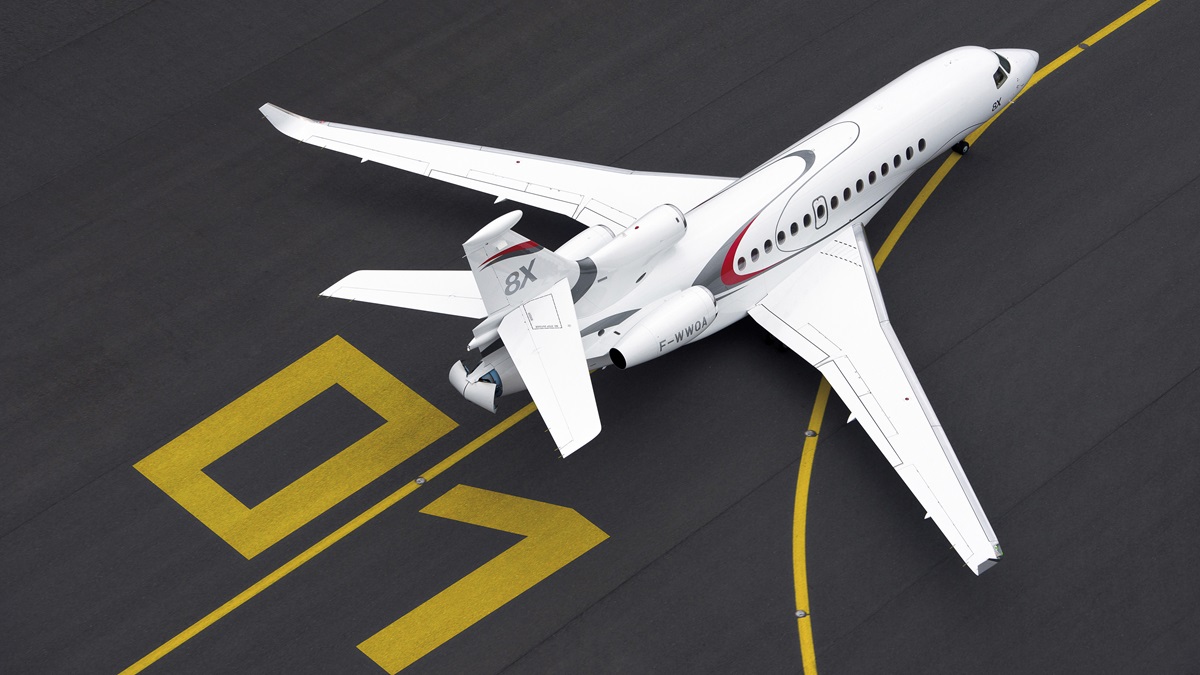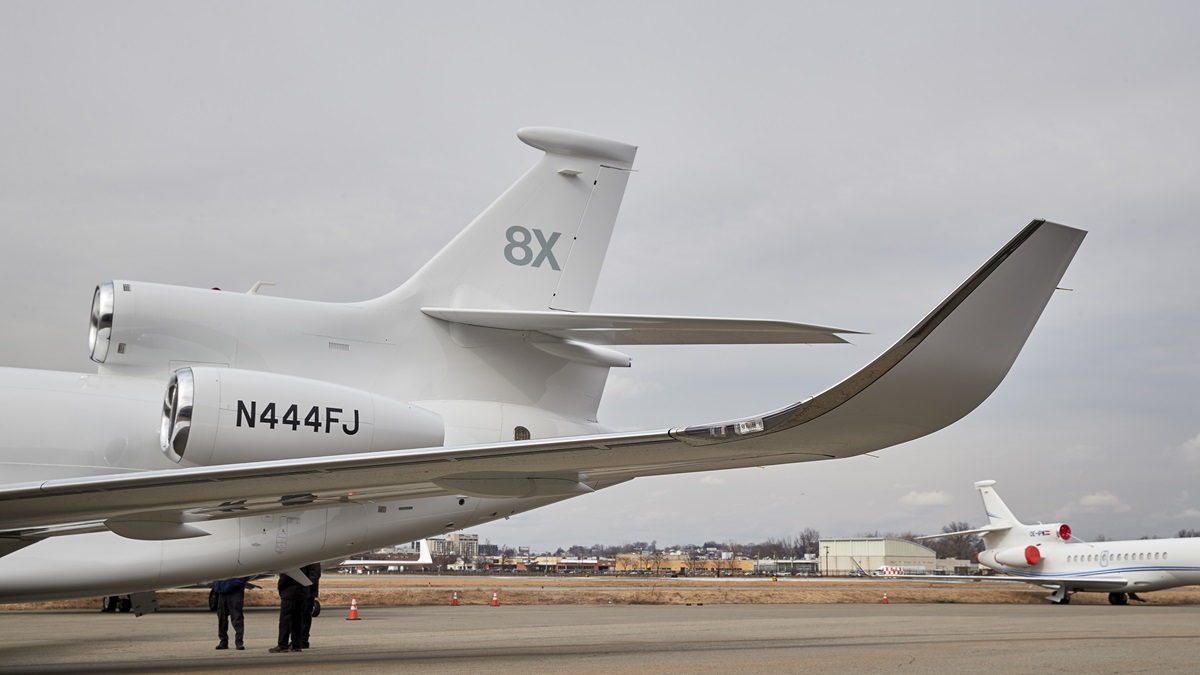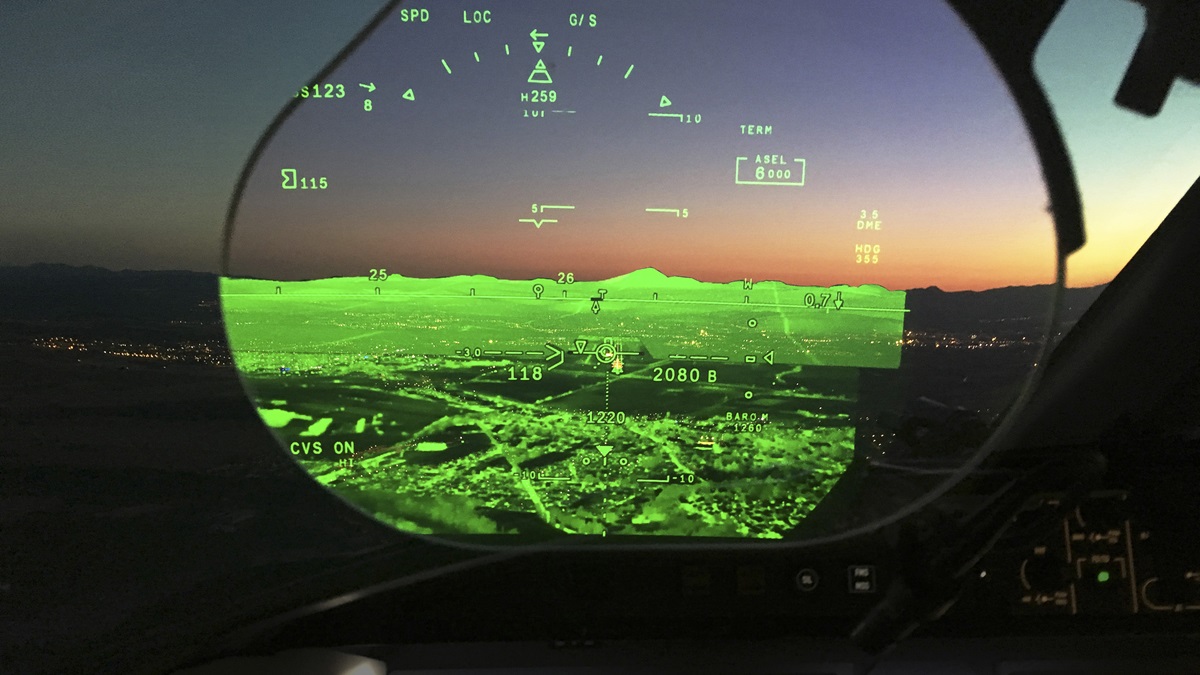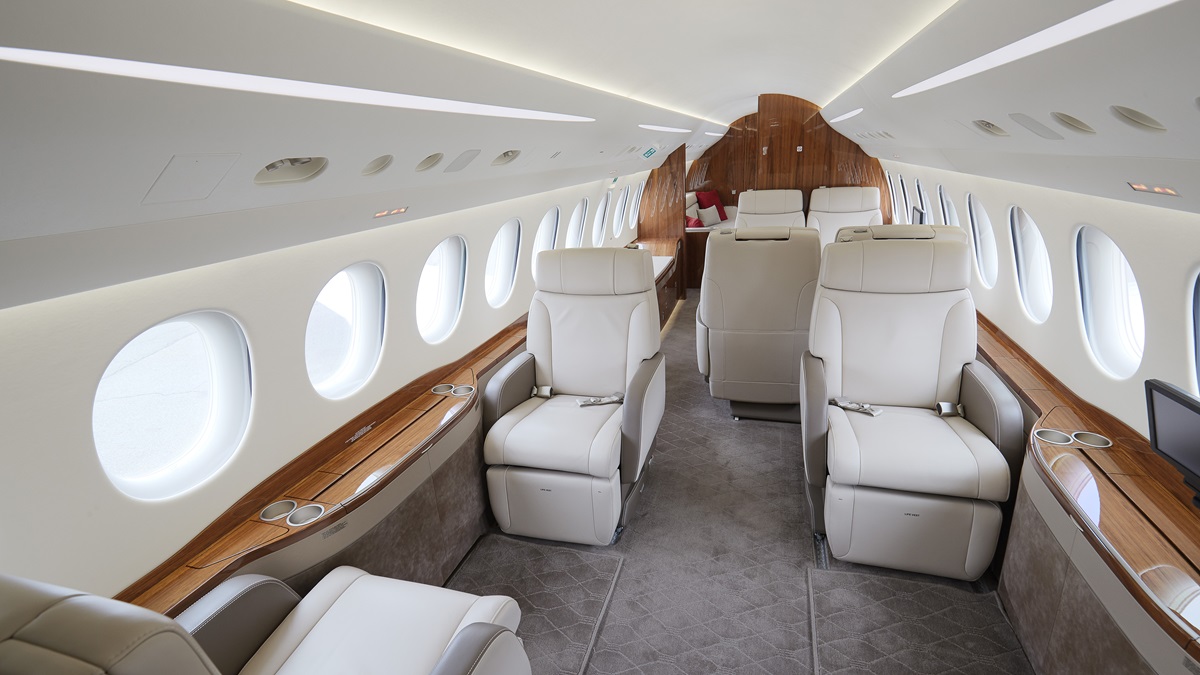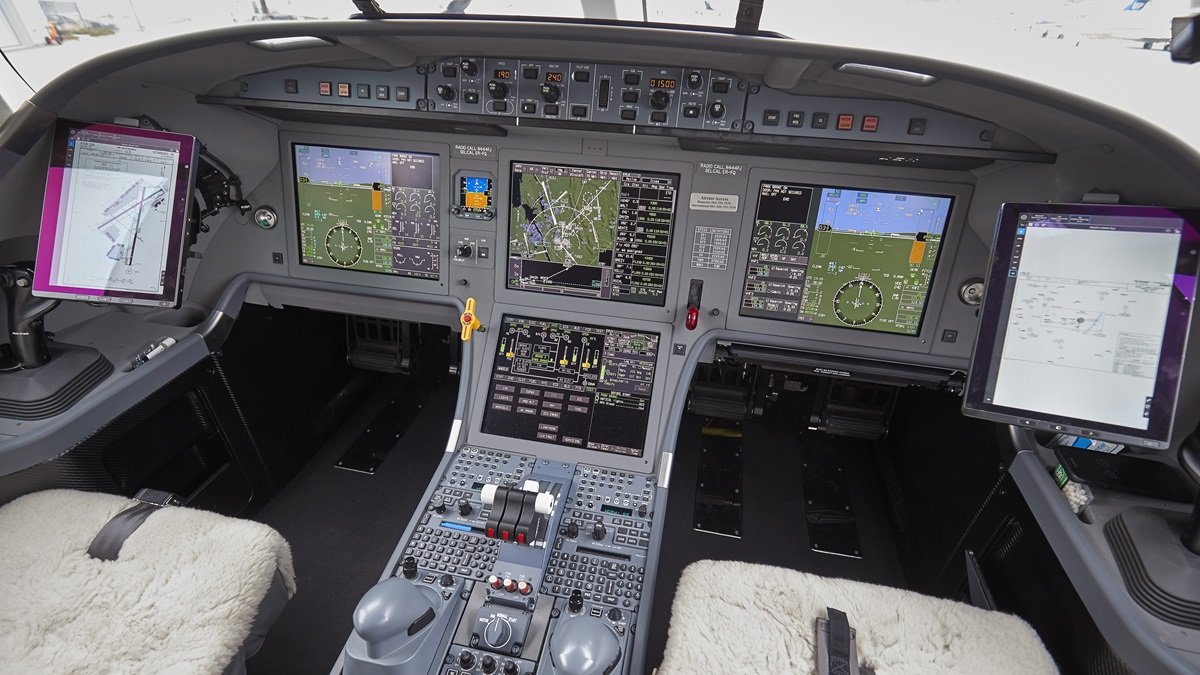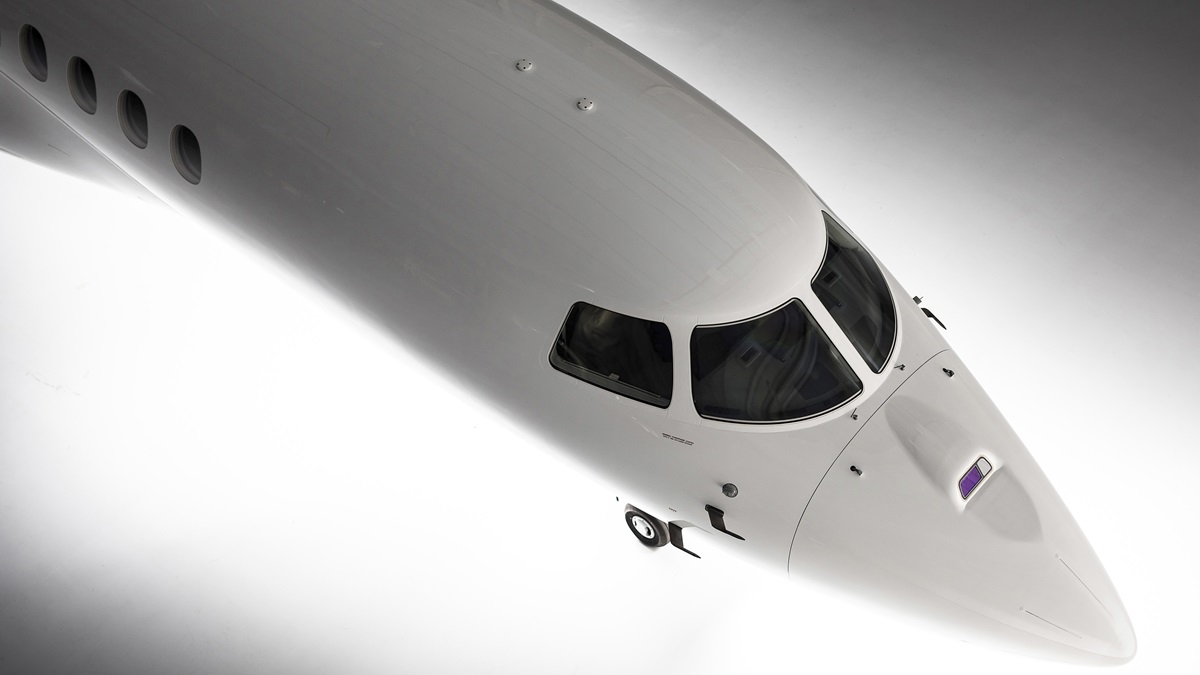FalconEye flying
The Falcon 8X combines synthetic terrain and infrared imagery in its new HUD
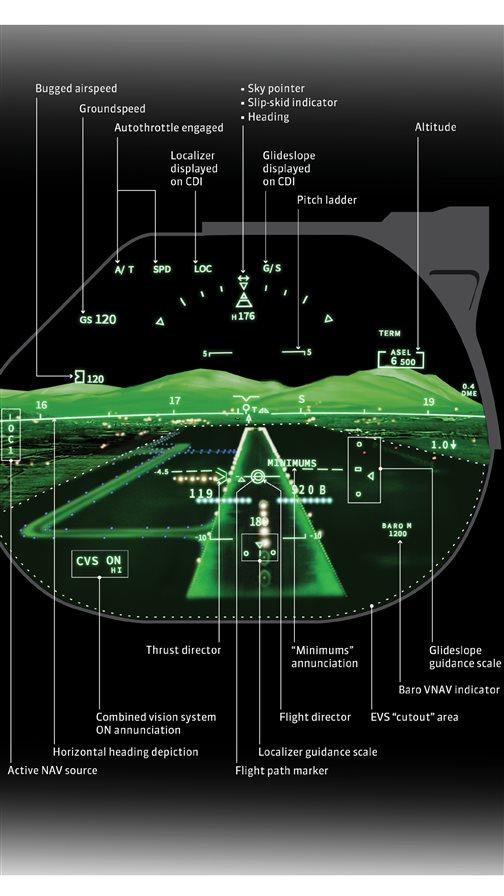 DNA
DNA
Dassaut Falcon Jet Corporation’s promotional materials and advertisements never fail to mention that the more recent Falcon models get their DNA, in large part, from the fly-by-wire control systems developed for the Rafale. So the merging of aesthetics and technology accounts for much of the inspirational quality emanating from the Falcon designs. The three-engine design of many of its models—the Falcons 50, 900, and 7X—doesn’t hurt, either.
About that trijet design: Falcon claims it provides several advantages over conventional, twin-fan models. First, the added redundancy is a great comfort to many customers who fly long overwater legs. Three engines also obviate the need for nearby alternate airports, which means more direct routes can be flown. In fact, losing an engine is considered an abnormal procedure, not an emergency. Besides, Falcon says that its three engines are actually more fuel efficient than flying with two much larger, more powerful engines, yielding a $1,621-per-hour fuel cost advantage over its competitors.
Fly-by-wire roots
The Falcon 7X debuted in 2005. It was the first business jet to use a fly-by-wire, digital flight control system. Banished were the traditional push rods, cables, bellcranks, springs, bobweights, and counterweights—which were directly and mechanically connected in some fashion to the pilots’ control yokes and rudder pedals. Replacing all that were digital signals from three dual-channel main plus three single-channel secondary flight control computers, designed and programmed to enhance safety by optimizing the airplane’s flight path, minimizing the effects of turbulence, maintaining smooth and coordinated flight, enhancing stability, and preventing the airplane from exceeding the limits of its flight envelope. Perhaps the nicest feature? Once you’ve set your desired attitude, fly-by-wire’s autotrim function will maintain it. There’s no need to constantly jink the airplane this way and that to hold heading, pitch, or bank. In this sense it’s almost like having a full-time autopilot at work.
Under fly-by-wire, the pilot or autopilot still controls the airplane, still makes control inputs—but these are translated into the form of signals sent to flight computers. The flight computers monitor and modify those inputs, moving a combination of control surfaces—all the time obeying a set of control laws set to take effect given the airplane’s configuration, phase of flight, and other variables. It’s a control method that lessens the pilot’s workload.
Can you stall a fly-by-wire airplane such as the 7X, dive it past VMO or MMO, or overstress its wings? No, the control logic will prevent these events. Approach a stall and the nose will lower. If the autopilot is on, the autothrottles will advance, all automatically. Overbank, and the control yoke will fight you once past 35 degrees; release the yoke, and the bank angle will return to its bank limit.
Falcon 8X
Today’s Falcon 8X is Dassault’s flagship. An evolution of the 7X (it even shares its type designator—DA-7X), the 8X’s exterior and cabin length are slightly longer than those of the 7X, but there are other notable improvements.
The 8X’s Pratt & Whitney PW307D engines have 6,722 pounds static thrust—that’s 5 percent more than the 7X’s engines—but they’re more fuel efficient thanks to an improved fan seal, new impeller clearances, and new full-authority digital engine controls (FADECs).
At 73,000 pounds, its maximum takeoff weight is 3,000 pounds greater than the 7X’s. By taking out 600 pounds from the solid milled-aluminum wing skins it has a similar basic operating weight, but a bigger payload. By adding new, blended winglets, the 8X can carry 2,960 pounds (about 401 gallons) more fuel, and thus has a greater maximum range (6,450 nautical miles) than the 7X (5,950 nm.)
The 8X has reinforced landing gear structures and new, three-rotor brakes instead of the 7X’s four rotors. Customers complained about the 7X having noisy brakes, so the three-rotor brakes are retrofittable.
The new EASy III cockpit (EASy stands for Enhanced Avionics System) is the newest iteration of Honeywell’s Primus Epic platform, and includes a new flight management system comprising three synchronously operating units. There’s also a new Honeywell RDR-4000 IntuVue 3-D radar, which automatically scans both horizontally and vertically to create a model of any convective clouds ahead.
FalconEye
Another big addition to the 8X cockpit is Dassault’s new FalconEye head-up display (HUD). With hardware designed by Elbit Systems, the FalconEye displays both synthetic vision and infrared imagery (known as enhanced vision in industry circles) simultaneously in what is called a combined vision system, or CVS. Honeywell has invested a lot in the CVS idea over the past decade, believing that for the best all-around situational awareness pilots need both synthetic and infrared sources when maneuvering for an approach or departure. The FalconEye is the first CVS, certified in 2016, and is a $500,000 option on the 8X. A dual HUD installation is expected soon.
FalconEye employs a split-screen methodology for manipulating the extent of the CVS and infrared views on the HUD. Pilots can adjust a line delineating the synthetic and infrared views up or down. Above the line a synthetic view of terrain appears in shades of green. Below the line appears an infrared, enhanced vision view.
The enhanced vision portion of the imagery is created using six multispectral sensors mounted in a housing on the nose—four optimized for daytime; one for night; and one for infrared, thermal sensing. These inputs are blended for the best view, and can see the newer, LED runway lighting now featured at more airports. Older infrared sensors have trouble seeing LED lighting because it emits much less heat.
During approaches, any synthetic terrain views automatically recede as the airplane flies down the final approach course, leaving a cutout showing an infrared view of the runway and its surroundings. As the airplane draws nearer to the threshold, the entire HUD progressively changes to an all-infrared view.
Superimposed over all this is illuminated HUD symbology showing vital flight information. This includes an attitude indicator, reference cues showing the airplane’s path, flight director cues for steering the airplane along the path, airspeed and altitude tapes, wind vector arrows, radar altimeter readouts, heading and pitch cues, acceleration cues for setting power for a bugged airspeed (when not using autothrottles), nav and autothrottle status annunciation, plus localizer and glideslope scales. Everything you’d need to see on the primary flight displays is presented on the HUD.
FalconEye does away with traditional, full-CDI or CDI-arc depictions for lateral guidance. Instead, an abbreviated scale is used to make the display simpler. There’s also a symbolic runway outline that drops away to an infrared/enhanced view as the infrared cutout expands as the airplane progresses to the runway.
The FalconEye system complies with the FAA’s new rules, FAR 91.176 (a) and (b) covering approaches with enhanced flight vision systems (EFVS). These rules allow pilots to obtain a letter of authorization to descend below approach minimums to 100 feet above the touchdown zone elevation if they see the required runway references using the EFVS. At that point, if the runway, the runway threshold, touchdown zone, or touchdown zone lights or markings can be seen with the pilot’s natural vision, then pilots can land, using natural vision.
It’s important to know that an enhanced vision system’s infrared sensors may be able to “see” through thin fog or light precipitation, but it cannot see through dense fog or thick clouds. That’s not its primary intended purpose, which is to improve natural vision at night, see hazards on or near the runway (such as people, deer, or equipment), expand an airplane’s ability to land in low visibility conditions, and dramatically boost overall situational awareness.
FalconEye flying
I was lucky enough to fly the 7X in 2013 and my luck held up again when I recently had a chance to fly the 8X with its FalconEye. My demo pilot this time was Falcon Chief Pilot Franco Nese. On the Falcon ramp at the company’s U.S. home field at the Teterboro, New Jersey, airport, Nese ran me through all the preflight checks, and soon we were ready for takeoff on Runway 24. With our 12,000-pound fuel load and safety pilot Carlos Correa, our takeoff weight was 49,038 pounds. Our takeoff airspeeds: a 108-knot V1, a 144-knot VR, and a 118-knot V2.
Then it was all three thrust levers up, the autothrottles took over, V1 and VR swept past, and after liftoff the flight director commanded a 20-degree pitch-up to join our departure path. It was a short flight to nearby Stewart International Airport in New York, where I’d fly some HUD-assisted approaches to Runway 9. By this time night had fallen.
With a 40-degree horizontal and 30-degree vertical field of view the HUD imagery is big, and when positioned properly it seems like it’s very close to your face. But this sensation—and the temptation to sneak a peek at the PFD, or peer around the HUD for a look ahead—goes away after a few minutes. By then you realize that everything you need to make an approach and landing is right on the HUD.
Turning to base leg, I spotted the FalconEye’s computer-generated representation of a sequenced flashing light array—the “rabbit”—leading me to the runway centerline. Using the flight path director, I rolled out on final, noticing that the CDI and glideslope indications were centered. Then it was a matter of lowering the leading-edge slats and flaps in increments, from the SF1 position; then gear down, slats and flaps to the SF2 position; then to SF3 with the autothrottles maintaining a VREF of 115 knots. It was a simple matter to see the terrain ahead using the upper, SVS portion of the HUD display. I could make out the hills and bridges over the Hudson River. Meanwhile, the lower, EVS portion of the display showed the runway in all its glory. It was a clear night, but I could see much more than I would have using my natural vision. I tried it once, and saw only the runway lights, surrounded by blackness.
After three low passes I was a HUD believer. Did I mention this was my first time using a HUD? After a half-hour or so I was comfortable enough to make a HUD-assisted approach and landing at Stewart. It was certainly a new experience to land an airplane while both scanning instruments and using visual cues with the FalconEye.
Almost half of the 42-plus 8Xs in the fleet are fitted with the FalconEye system. And while it may be the first CVS to make it to market, it certainly won’t be the last. Pilots may always debate the merits of fly-by-wire technology, but when it comes to HUDs with a CVS, few will doubt their value.
Email [email protected]

An 8X RON
A Falcon 8X demonstrator takes a break in its hangar, remaining overnight before the next chance to show off its nose-mounted FalconEye HUD sensors.
Where: Teterboro Airport, New Jersey
Photographer: Mike Fizer

